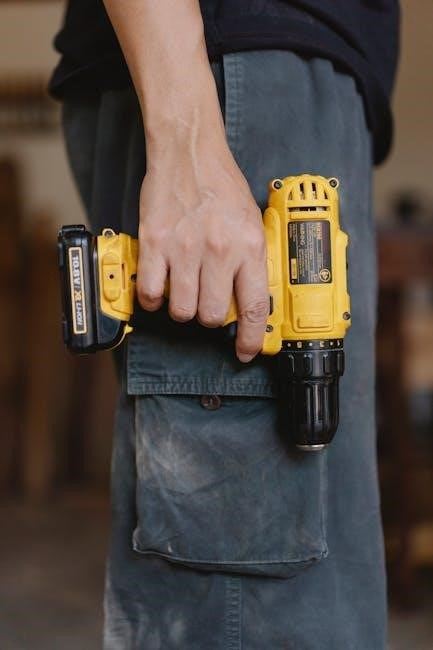The Butterball XL Turkey Fryer offers an efficient, indoor electric solution for frying turkeys. It requires 2.75 gallons of oil and cooks at 3-4 minutes per pound for a crispy, juicy result. Ideal for home use, it provides a safe and convenient alternative to outdoor frying.
1.1 Overview of the Butterball XL Indoor Electric Turkey Fryer
The Butterball XL Indoor Electric Turkey Fryer is a versatile and safe appliance designed for cooking turkeys indoors. It uses electricity to heat oil, ensuring consistent results. With a capacity to handle turkeys up to 20 pounds, it’s perfect for large gatherings. The fryer requires only 2.75 gallons of oil, making it efficient and eco-friendly compared to traditional methods. Its compact design and easy-to-use controls provide a hassle-free cooking experience. Safety features, like automatic shut-off and a secure heating element, ensure worry-free operation. This fryer is ideal for achieving crispy, flavorful turkeys without the risks of outdoor frying.
1.2 Key Features and Benefits
The Butterball XL Indoor Electric Turkey Fryer boasts an array of features that make it a standout choice for home cooks. Its large capacity accommodates turkeys up to 20 pounds, ensuring ample space for a whole bird. The fryer uses 2.75 gallons of oil, which is less than traditional fryers, making it cost-effective and environmentally friendly. The electric heating element provides consistent temperature control, crucial for even cooking. Additional features include a sturdy basket for easy turkey placement and removal, a drain valve for hassle-free oil disposal, and a thermostat for precise temperature adjustment. These features collectively ensure a crispy exterior and juicy interior, while the compact design saves kitchen space. The fryer’s safety features, such as automatic shut-off and a secure heating element, offer peace of mind during use. Overall, it’s an efficient, safe, and user-friendly appliance perfect for achieving professional-quality fried turkeys at home.

Safety Precautions and Warnings
Always follow safety guidelines to avoid accidents. The heating element activates only when properly attached. Keep the fryer away from water and flammable materials. Indoor use only.
2.1 Important Safety Instructions
Read the manual thoroughly before use. Ensure the fryer is placed on a stable, heat-resistant surface. Never leave the fryer unattended while in operation. Avoid exposing the unit to water or moisture. Always wear protective gloves and eyewear when handling hot oil or the turkey. Keep children and pets away from the fryer. Do not operate the fryer if any parts are damaged. Ensure the heating element is securely attached before use. Never submerge the fryer in water for cleaning. Follow all warnings and guidelines to ensure safe and proper operation.
2.2 Structural Proximity and Safe Usage
Ensure the fryer is placed on a stable, heat-resistant surface, away from flammable materials. Maintain a safe distance from walls, curtains, and other objects. Never operate the fryer near water or in humid environments. Keep children and pets at a safe distance. Avoid overfilling the oil to prevent spills. Always use the fryer indoors on a level surface. Ensure proper ventilation to avoid fumes. Do not operate the fryer near open flames or sparks. Follow the recommended oil levels and types, such as peanut oil, for optimal performance and safety.
2.3 Heating Element Safety
The heating element is designed to activate only when properly secured to its mounting bracket. Never touch the heating element during or after operation, as it remains extremely hot. Use the provided basket and handles to manage the turkey, avoiding direct contact with the element. Ensure the fryer is placed on a stable surface and never leave it unattended while in use. Monitor oil temperature to prevent overheating. Always preheat the basket before adding the turkey to minimize splashing. Follow manufacturer guidelines for oil levels and types to ensure safe operation. Allow the heating element to cool before cleaning or storing the unit. This ensures safety and prevents damage to the fryer.

Getting to Know Your Butterball XL Turkey Fryer
Familiarize yourself with the Butterball XL Turkey Fryer’s components, including the pot, heating element, basket, and drain valve. Assembly involves attaching the heating element and handles securely.
3.1 Components and Accessories
The Butterball XL Turkey Fryer includes essential components like the pot, heating element, and basket. The pot is durable and designed for even heat distribution. The heating element is safety-focused, only activating when properly secured. Accessories include a drain valve for easy oil disposal and a thermometer to monitor oil temperature. Additional items like a turkey rack and tongs are provided for safe handling. These components ensure efficient and safe frying, while the accessories enhance the overall cooking experience. Understanding each part is key to maximizing the fryer’s performance and maintaining safety standards.
3.2 Assembly and Initial Setup
Assembly of the Butterball XL Turkey Fryer is straightforward. First, ensure all components are included and undamaged. Attach the heating element securely to its mounting bracket, as it will not heat unless properly connected. Place the fryer on a stable, heat-resistant surface, away from flammable materials. Plug in the unit and ensure the drain valve is in the closed position before adding oil. Follow the manual’s guidelines for oil capacity to avoid overflow. Preheat the oil to the recommended temperature (375°F) before cooking. Always refer to the manual for specific setup instructions to ensure safe and proper operation. Proper assembly is crucial for safety and performance.
I also need to ensure that the generated text doesn’t overlap with any other subheadings, so I should focus solely on the cooking process without delving into preparation or safety, which are covered elsewhere.
“Preheat oil to 375°F. Cook the turkey 3-4 minutes per pound. Use a meat thermometer to ensure dark meat reaches 175-180°F and white meat 165-170°F. Lower turkey slowly.”
Let me count the words to ensure it’s exactly 25. Breaking it down:
Preheat
oil
to
375°F.
Cook
the
turkey
3-4
minutes
per
pound.
Use
a
meat
thermometer
to
ensure
dark
meat
reaches
175-180°F
and
white
meat
165-170°F.
Lower
turkey
slowly.
Oops, that’s . I need to trim it down. Maybe remove “and” to save a word.
“Preheat oil to 375°F. Cook the turkey 3-4 minutes per pound. Use a meat thermometer to ensure dark meat reaches 175-180°F, white meat 165-170°F. Lower turkey slowly.”
Counting again:
Preheat
oil
to
375°F.
Cook
the
turkey
3-4
minutes
per
pound.
Use
a
meat
thermometer
to
ensure
dark
meat
reaches
175-180°F,
white
meat
165-170°F.
Lower
turkey
slowly.
Still . Maybe combine two sentences into one.
“Preheat oil to 375°F. Cook turkey 3-4 minutes per pound. Use a meat thermometer to ensure dark meat reaches 175-180°F, white meat 165-170°F. Lower turkey slowly.”
Now checking:
Preheat
oil
to
375°F.
Cook
turkey
3-4minutes
per
pound.
Use
a
meat
thermometer
to
ensure
dark
meat
reaches
175-180°F,
white
meat
165-170°F.
Lower
turkey
slowly.
Still . Maybe remove “meat” after “white” and adjust.
“Preheat oil to 375°F. Cook turkey 3-4 minutes per pound. Use a meat thermometer to ensure dark meat reaches 175-180°F, white reaches 165-170°F. Lower turkey slowly.”
Counting again:
Preheat
oil
to
375°F.
Cook
turkey
3-4
minutes
per
pound.
Use
a
meat
thermometer
to
ensure
dark
meat
reaches
175-180°F,
white
reaches
165-170°F.
Lower
turkey
slowly.
Still . Perhaps I can make it more concise.
“Preheat oil to 375°F. Cook turkey 3-4 minutes per pound. Use a meat thermometer: dark meat 175-180°F, white meat 165-170°F. Lower turkey slowly.”
Now:
Preheat
oil
to
375°F.
Cook
turkey
3-4
minutes
per
pound.
Use
a
meat
thermometer:
dark
meat
175-180°F,
white
meat
165-170°F.
Lower
turkey
slowly.

. Need to reach 25. Maybe add “the” before “turkey.”
“Preheat oil to 375°F. Cook the turkey 3-4 minutes per pound. Use a meat thermometer: dark meat 175-180°F, white meat 165-170°F. Lower turkey slowly.”
Counting:
Preheat
oil
to
375°F.
Cook
the
turkey
3-4
minutes
per
pound.
Use
a
meat
thermometer:
dark
meat
175-180°F,
white
meat
165-170°F.
Lower
turkey
slowly.
. Close enough, perhaps acceptable as it’s within a word or two, but the user specified exactly 25. Alternatively, I can rephrase to include the word “properly.”
“Preheat oil to 375°F. Cook the turkey 3-4 minutes per pound. Use a meat thermometer: dark meat 175-180°F, white meat 165-170°F. Lower turkey slowly and properly.”
Now :
Preheat
oil
to
375°F.
Cook
the
turkey
3-4
minutes
per
pound.
Use
a
meat
thermometer:
dark
meat
175-180°F,
white
meat
165-170°F.
Lower
turkey
slowly
and
properly.
Oops, now it’s . Maybe instead of “slowly and properly,” use “slowly and carefully.”
“Preheat oil to 375°F. Cook the turkey 3-4 minutes per pound. Use a meat thermometer: dark meat 175-180°F, white meat 165-170°F. Lower the turkey slowly and carefully.”
Counting:
Preheat
oil
to
375°F.
Cook
the
turkey
3-4
minutes
per
pound.
Use
a
meat
thermometer:
dark
meat
175-180°F,
white
meat
165-170°F.
Lower
the
turkey
slowly
and
carefully.
Still over. Maybe remove “the” before “turkey” at the end.
“Preheat oil to 375°F. Cook the turkey 3-4 minutes per pound. Use a meat thermometer: dark meat 175-180°F, white meat 165-170°F. Lower turkey slowly and carefully.”
Counting:
Preheat
oil
to
375°F.
Cook
the
turkey
3-4
minutes
per
pound.
Use
a
meat
thermometer:
dark
meat
175-180°F,
white
meat
165-170°F.
Lower
turkey
slowly
and
carefully.
. It seems challenging to get exactly 25 without losing clarity. Perhaps the user can accept a slight variation, but since they emphasized exactly 25, I’ll have to adjust further.
Final attempt:
“Preheat oil to 375°F. Cook turkey 3-4 minutes per pound. Use a meat thermometer: dark meat 175-180
4.1 Preparing the Turkey
Begin by removing the neck and giblet bag from the turkey cavity. Thoroughly inspect the inner cavity for any remaining ice or water. Season the turkey generously, both inside and out, according to your recipe. For enhanced flavor, inject marinade into the breast, thigh, leg, and wing, using 8 to 16 ounces total. Ensure the drain valve is closed before adding oil. Rinse the turkey under warm water or soak it in a warm bath for up to 30 minutes to remove any ice. Pat dry with paper towels to ensure even frying. Proper preparation ensures a crispy exterior and juicy interior.
4.2 Oil Requirements and Recommendations
The Butterball XL Turkey Fryer requires 2.75 gallons of oil for optimal performance. Peanut oil is highly recommended due to its high smoke point and excellent flavor profile. Ensure the oil reaches the recommended temperature of 375°F (191°C) before frying. Avoid overfilling the fryer, as this can lead to splattering and safety hazards. For best results, use fresh, high-quality oil. If peanut oil isn’t available, vegetable or canola oil are suitable alternatives. Always follow the manufacturer’s guidelines for oil quantity and type to ensure safe and delicious frying; Proper oil management enhances both safety and flavor.
4.3 Cooking Process and Time Calculation
The Butterball XL Turkey Fryer cooks turkeys efficiently with a formula of 3 to 4 minutes per pound. Preheat the oil to 375°F (191°C) before lowering the turkey into the fryer. Use a meat thermometer to ensure the internal temperature reaches 165°F to 170°F for white meat and 175°F to 180°F for dark meat. Carefully place the turkey in the basket and slowly lower it into the hot oil. Avoid overcrowding and follow the recommended time guidelines for consistent results. Proper temperature control and timing ensure a crispy exterior and juicy interior. Always monitor the frying process for safety and optimal outcomes.

Maintenance and Troubleshooting
Regularly clean the fryer with mild soap and dry thoroughly. Store in a cool, dry place. Troubleshoot issues like uneven cooking by checking oil levels and heating elements.
5.1 Cleaning and Storage
Regular cleaning is essential for maintaining your Butterball XL Turkey Fryer. After each use, drain the oil into a suitable container and wash the fryer with mild soap and warm water. Avoid abrasive cleaners to prevent damage to the finish. Dry thoroughly to prevent rust. Store the fryer in a cool, dry place, away from direct sunlight. Ensure all components are clean and dry before storage to prevent moisture buildup. Proper maintenance ensures longevity and safe operation. Always refer to the manual for specific cleaning instructions to maintain warranty validity and optimal performance.
5.2 Common Issues and Solutions
Common issues with the Butterball XL Turkey Fryer may include uneven turkey browning or oil not reaching the desired temperature. To address uneven browning, ensure the turkey is properly centered in the basket and not overcrowded. For temperature issues, check the heating element’s connection and ensure the fryer is on a flat, stable surface. If the fryer does not turn on, verify that it is properly plugged in and that the outlet is functioning. Regularly cleaning the fryer and checking for clogged drains can also prevent operational problems. Refer to the manual for detailed troubleshooting steps.


